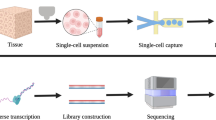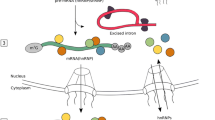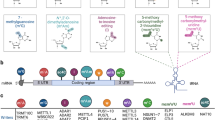Abstract
RNA interference (RNAi) is an evolutionarily conserved process that silences gene expression through double-stranded RNA species in a sequence-specific manner. With the completion of genome sequencing in multiple organisms, RNAi provides an efficient reverse genetics tool to reveal gene functions on a genome-wide scale. Conditional/inducible RNAi offers a new way to analyze gene function at different developmental stages and to create a new generation of animal models of human diseases. The sequence-specificity of RNAi and the fact that it is a naturally occurring process in human make it an excellent therapeutic tool for a wide range of diseases. This article provides a brief review of the current understandings of the mechanism of RNAi and its application to the nervous system, with particular focus on its application to understand mechanisms of neurodegenerative diseases. The prospects of the application of RNAi in clinical setting to treat these devastating diseases will also be presented.
Similar content being viewed by others
References
Ashrafi K., Chang F. Y., Watts J. L., et al. (2003) Genome-wide RNAi analysis of Caenorhabditis elegans fat regulatory genes. Nature 421, 268–272.
Berns K., Hijmans E. M., Mullenders J., et al. (2004) A large-scale RNAi screen in human cells identifies new components of the p53 pathway. Nature 428, 431–437.
Bernstein E., Caudy A. A., Hammond S. M., and Hannon G. J. (2001) Role for a bidentate ribonuclease in the initiation step of RNA interference. Nature 409, 363–366.
Bonifati V., Rizzu P., van Baren M. J., et al. (2003) Mutations in the DJ-1 gene associated with autosomal recessive early-onset parkinsonism. Science 299, 256–259.
Boutros M., Kiger A. A., Armknecht S., et al. (2004) Genome-wide RNAi analysis of growth and viability in Drosophila cells. Science 303, 832–835.
Brennecke J., Hipfner D. R., Stark A., Russell R. B., and Cohen S. M. (2003) Bantam encodes a developmentally regulated microRNA that controls cell proliferation and regulates the proapoptotic gene hid in Drosophila. Cell 113, 25–36.
Bridge A. J., Pebernard S., Ducraux A., Nicoulaz A. L., and Iggo R. (2003) Induction of an interferon response by RNAi vectors in mammalian cells. Nat. Genet. 34, 263–264.
Brummelkamp T. R., Bernards R., and Agami R. (2002a) Stable suppression of tumorigenicity by virus-mediated RNA interference. Canc. Cell 2, 243–247.
Brummelkamp T. R., Bernards R., and Agami R. (2002b) A system for stable expression of short interfering RNAs in mammalian cells. Science 296, 550–553.
Brummelkamp T. R., Nijman S. M., Dirac A. M., and Bernards R. (2003) Loss of the cylindromatosis tumour suppressor inhibits apoptosis by activating NF-κB. Nature 424, 797–801.
Byrnes A. P., Rusby J. E., Wood M. J., and Charlton H. M. (1995) Adenovirus gene transfer causes inflammation in the brain. Neuroscience 66, 1015–1024.
Calegari F., Haubensak W., Yang D., Huttner W. B., and Buchholz F. (2002) Tissue-specific RNA interference in postimplantation mouse embryos with endoribonuclease-prepared short interfering RNA. Proc. Natl. Acad. Sci. USA 99, 14,236–142,240.
Caplen N. J., Fleenor J., Fire A., and Morgan R. A. (2000) dsRNA-mediated gene silencing in cultured Drosophila cells: a tissue culture model for the analysis of RNA interference. Gene 252, 95–105.
Christensen M., Estevez A., Yin X., et al. (2002) A primary culture system for functional analysis of C. elegans neurons and muscle cells. Neuron 33, 503–514.
Coburn G. A. and Cullen B. R. (2002) Potent and specific inhibition of human immunodeficiency virus type 1 replication by RNA interference. J. Virol. 76, 9225–9231.
Dostie J., Mourelatos Z., Yang M., Sharma A., and Dreyfuss G. (2003) Numerous microRNPs in neuronal cells containing novel microRNAs. RNA 9, 180–186.
Dougherty W. G., Lindbo J. A., Smith H. A., Parks T. D., Swaney S., and Proebsting W. M. (1994) RNA-mediated virus resistance in transgenic plants: exploitation of a cellular pathway possibly involved in RNA degradation. Mol. Plant Microbe Interact. 7, 544–552.
Downward J. (2004) RNA interference. BMJ 328, 1245–1248.
Dykxhoorn D. M., Novina C. D., and Sharp P. A. (2003) Killing the messenger: short RNAs that silence gene expression. Nat. Rev. Mol. Cell Biol. 4, 457–467.
Eaton B. A., Fetter R. D., and Davis G. W. (2002) Dynactin is necessary for synapse stabilization. Neuron 34, 729–741.
Elbashir S. M., Harborth J., Lendeckel W., Yalcin A., Weber K., and Tuschl T. (2001) Duplexes of 21-nucleotide RNAs mediate RNA interference in cultured mammalian cells. Nature 411, 494–498.
Fernandez-Funez P., Nino-Rosales M. L., de Gouyon B., et al. (2000) Identification of genes that modify ataxin-1-induced neurodegeneration. Nature 408, 101–106.
Fire A., Xu S., Montgomery M. K., Kostas S. A., Driver S. E., and Mello C. C. (1998) Potent and specific genetic interference by double-stranded RNA in Caenorhabditis elegans. Nature 391, 806–811.
Gil J. and Esteban M. (2000) Induction of apoptosis by the dsRNA-dependent protein kinase (PKR): mechanism of action. Apoptosis 5, 107–114.
Goldberg M. S., Fleming S. M., Palacino J. J., et al. (2003) Parkin-deficient mice exhibit nigrostriatal deficits but not loss of dopaminergic neurons. J. Biol. Chem. 278, 43,628–43,635.
Gonczy P., Echeverri C., Oegema K., et al. (2000) Functional genomic analysis of cell division in C. elegans using RNAi of genes on chromosome III. Nature 408, 331–336.
Gonzalez-Alegre P., Miller V. M., Davidson B. L., and Paulson H. L. (2003) Toward therapy for DYT1 dystonia: allele-specific silencing of mutant TorsinA. Ann. Neurol. 53, 781–787.
Greene J. C., Whitworth A. J., Kuo I., Andrews L. A., Feany M. B., and Pallanck L. J. (2003) Mitochondrial pathology and apoptotic muscle degeneration in Drosophila parkin mutants. Proc. Natl. Acad. Sci. USA 100, 4078–4083.
Guo S. and Kemphues K. J. (1995) par-1, A gene required for establishing polarity in C. elegans embryos, encodes a putative Ser/Thr kinase that is asymmetrically distributed. Cell 81, 611–620.
Hamilton A. J. and Baulcombe D. C. (1999). A species of small antisense RNA in posttranscriptional gene silencing in plants. Science 286, 950–952.
Hammond S. M., Bernstein E., Beach D. and Hannon G. J. (2000). An RNA-directed nuclease mediates post-transcriptional gene silencing in Drosophila cells. Nature 404, 293–296.
Hannon G. J., (2002). RNA interference. Nature 418, 244–251.
Hardy J. and Selkoe D. J., (2002). The amyloid hypothesis of Alzheimer’s disease: progress and problems on the road to therapeutics. Science 297, 353–356.
Hasuwa H., Kaseda K., Einarsdottir T., and Okabe M. (2002) Small interfering RNA and gene silencing in transgenic mice and rats. FEBS Lett. 532, 227–230.
Hasuwa H., and Okabe M. (2004). RNAi in living mice. Meth. Mol. Biol. 252, 501–508.
Itier J. M., Ibanez P., Mena M. A., et al. (2003) Parkin gene inactivation alters behaviour and dopamine neurotransmission in the mouse. Hum. Mol. Genet. 12, 2277–2291.
Jackson A. L., Bartz S. R., Schelter J., et al. and Linsley P. S. (2003) Expression profiling reveals off-target gene regulation by RNAi. Nat. Biotechnol. 21, 635–637.
Jiang C. and Schuman E. M. (2002). Regulation and function of local protein synthesis in neuronal dendrites. Trends Biochem. Sci. 27, 506–513.
Job C. and Eberwine J. (2001). Localization and translation of mRNA in dendrites and axons. Nat. Rev. Neurosci. 2, 889–898.
Kalidas S. and Smith D. P. (2002). Novel genomic cDNA hybrids produce effective RNA interference in adult Drosophila. Neuron 33, 177–184.
Kamath R. S., Fraser A. G., Dong Y., et al. (2003) Systematic functional analysis of the Caenorhabditis elegans genome using RNAi. Nature 421, 231–237.
Kao S. C., Krichevsky A. M., Kosik K. S., and Tsai L. H. (2004). BACE1 suppression by RNA interference in primary cortical neurons. J. Biol. Chem. 279, 1942–1949.
Kennerdell J. R. and Carthew R. W. (1998). Use of dsRNA-mediated genetic interference to demonstrate that frizzled and frizzled 2 act in the wingless pathway. Cell 95, 1017–1026.
Kennerdell J. R. and Carthew R. W. (2000). Heritable gene silencing in Drosophila using double-stranded RNA. Nat. Biotechnol. 18, 896–898.
Ketting R. F., Fischer S. E., Bernstein E., Sijen T., Hannon G. J., and Plasterk R. H. (2001). Dicer functions in RNA interference and in synthesis of small RNA involved in developmental timing in C. elegans. Gene Dev. 15, 2654–2659.
Kiger A., Baum B., Jones S., et al. (2003). A functional genomic analysis of cell morphology using RNA interference J. Biol. 2, 27.
Kim J., Krichevsky A., Grad Y., et al. (2004a). Identification of many microRNAs that copurify with polyribosomes in mammalian neurons. Proc. Natl. Acad. Sci. USA 101, 360–365.
Kim Y. O., Park S. J., Balaban R. S., Nirenberg M., and Kim Y. (2004b). A functional genomic screen for cardiogenic genes using RNA interference in developing Drosophila embryos. Proc. Natl. Acad. Sci. USA 101, 159–164.
Kitada T., Asakawa S., Hattori N., et al. (1998). Mutations in the parkin gene cause autosomal recessive juvenile parkinsonism. Nature 392, 605–608.
Knight S. W. and Bass B. L. (2001). A role for the RNase III enzyme DCR-1 in RNA interference and germ line development in Caenorhabditis elegans. Science 293, 2269–2271.
Korneev S. A., Kemenes I., Straub V., et al. (2002). Suppression of nitric oxide (NO)-dependent behavior by double-stranded RNA-mediated silencing of a neuronal NO synthase gene. J. Neurosci. 22, RC227.
Krichevsky A. M. and Kosik K. S. (2002). RNAi functions in cultured mammalian neurons. Proc. Natl. Acad. Sci. USA 99, 11,926–11,929.
Kumagai M. H., Donson J., della-Cioppa G., Harvey D., Hanley K., and Grill L. K. (1995). Cytoplasmic inhibition of carotenoid biosynthesis with virus-derived RNA. Proc. Natl. Acad. Sci. USA 92, 1679–1683.
Lau N. C., Lim L. P., Weinstein E. G., and Bartel D. P. (2001). An abundant class of tiny RNAs with probable regulatory roles in Caenorhabditis elegans. Science 294, 858–862.
Lee R. C. and Ambros V. (2001). An extensive class of small RNAs in Caenorhabditis elegans. Science 294, 862–864.
Lee R. C., Feinbaum, R. L., and Ambros V. (1993). The C. elegans heterochronic gene lin-4 encodes small RNAs with antisense complementarity to lin-14. Cell 75, 843–854.
Lee S. S., Lee R. Y., Fraser A. G., Kamath R. S., Ahringer J., and Ruvkun G. (2003). A systematic RNAi screen identifies a critical role for mitochondria in C. elegans longevity. Nat. Genet. 33, 40–48.
Lee Y. S., Nakahara K., Pham J. W., et al. (2004). Distinct roles for Drosophila Dicer-1 and Dicer-2 in the siRNA / miRNA silencing pathways. Cell 117, 69–81.
Lim L. P., Glasner M. E., Yekta S., Burge C. B., and Bartel D. P. (2003a). Vertebrate microRNA genes. Science 299, 1540.
Lim L. P., Lau N. C., Weinstein E. G., et al. (2003b). The microRNAs of Caenorhabditis elegans. Genes Dev 17, 991–1008.
Lin R., Thompson S., and Priess J. R. (1995). pop-1 Encodes an HMG box protein required for the specification of a mesoderm precursor in early C. elegans embryos. Cell 83, 599–609.
Lum L., Yao S., Mozer B., et al. (2003). Identification of Hedgehog pathway components by RNAi in Drosophila cultured cells. Science 299, 2039–2045.
Martin K. C., and Kosik K. S. (2002). Synaptic tagging—who’s it? Nat. Rev. Neurosci. 3, 813–820.
Martinek S. and Young M. W. (2000). Specific genetic interference with behavioral rhythms in Drosophila by expression of inverted repeats. Genetics 156, 1717–1725.
Matsuda T. and Cepko C. L. (2004). Electroporation and RNA interference in the rodent retina in vivo and in vitro. Proc. Natl. Acad. Sci. USA 101, 16–22.
Matsukura S., Jones P. A., and Takai D. (2003). Establishment of conditional vectors for hairpin siRNA knockdowns. Nucleic Acids Res. 31, e77.
Maxwell M. M., Pasinelli P., Kazantsev A. G., and Brown R. H., Jr. (2004). RNAinterference-mediated silencing of mutant superoxide dismutase rescues cyclosporin A-induced death in cultured neuroblastoma cells. Proc. Natl. Acad. Sci. USA 101, 3178–3183.
McCaffrey A. P., Nakai H., Pandey K., et al. (2003). Inhibition of hepatitis B virus in mice by RNA interference. Nat. Biotechnol. 21, 639–644.
Miller V. M., Xia H., Marrs G. L., et al. (2003). Allele-specific silencing of dominant disease genes. Proc. Natl. Acad. Sci. USA 100, 7195–7200.
Murphy C. T., McCarroll S. A., Bargmann C. I., et al. (2003). Genes that act downstream of DAF-16 to influence the lifespan of Caenorhabditis elegans. Nature 424, 277–283.
Napoli C., Lemieux C., and Jorgensen R. (1990). Introduction of a chimeric chalcone synthase gene into petunia results in reversible co-suppression of homologous genes in trans. Plant Cell 2, 279–289.
Nollen E. A., Garcia S. M., van Haaften G., et al. (2004). Genome-wide RNA interference screen identifies previously undescribed regulators of polyglutamine aggregation. Proc. Natl. Acad. Sci. USA 101, 6403–6408.
Novina C. D. and Sharp P. A. (2004). The RNAi revolution. Nature 430, 161–164.
Paddison P. J., Caudy A. A., Bernstein E., Hannon G. J., and Conklin D. S. (2002). Short hairpin RNAs (shRNAs) induce sequence-specific silencing in mammalian cells. Gene Dev. 16, 948–958.
Paddison P. J., Silva J. M., Conklin D. S., et al. (2004). Aresource for large-scale RNA-interference-based screens in mammals. Nature 428, 427–431.
Pham J. W., Pellino J. L., Lee Y. S., Carthew R. W., and Sontheimer E. J. (2004). A Dicer-2-dependent 80s complex cleaves targeted mRNAs during RNAi in Drosophila. Cell 117, 83–94.
Pothof J., van Haaften G., Thijssen K., et al. (2003). Identification of genes that protect the C. elegans genome against mutations by genome-wide RNAi. Gene Dev. 17, 443–448.
Ramet M., Manfruelli P., Pearson A., Mathey-Prevot B., and Ezekowitz R. A. (2002). Functional genomic analysis of phagocytosis and identification of a Drosophila receptor for E. coli. Nature 416, 644–648.
Romano N. and Macino G. (1992). Quelling: transient inactivation of gene expression in Neurospora crassa by transformation with homologous sequences. Mol. Microbiol. 6, 3343–3353.
Scherr M., Battmer K., Winkler T., Heidenreich O., Ganser A. and Eder M. (2003). Specific inhibition of bcr-abl gene expression by small interfering RNA. Blood 101, 1566–1569.
Shinagawa T. and Ishii S. (2003). Generation of Ski-knockdown mice by expressing a long double-strand RNA from an RNA polymerase II promoter. Gene Dev. 17, 1340–1345.
Staropoli J. F., McDermott C., Martinat C., Schulman B., Demireva E. and Abeliovich A. (2003). Parkin is a component of an SCF-like ubiquitin ligase complex and protects postmitotic neurons from kainate excitotoxicity. Neuron 37, 735–749.
Sui G., Soohoo C., Affar el B., Gay F., Shi Y. and Forrester W. C. (2002). ADNA vector-based RNAi technology to suppress gene expression in mammalian cells. Proc. Natl. Acad. Sci. USA 99, 5515–5520.
Takasugi N., Tomita T., Hayashi I., et al. (2003). The role of presenilin cofactors in the gamma-secretase complex. Nature 422, 438–441.
Tijsterman M., and Plasterk R. H. (2004). Dicers at RISC; the mechanism of RNAi. Cell 117, 1–3.
Timmons L., Court D. L., and Fire A. (2001). Ingestion of bacterially expressed dsRNAs can produce specific and potent genetic interference in Caenorhabditis elegans. Gene 263, 103–112.
Trulzsch B., Davies K., and Wood M. (2004). Survival of motor neuron gene downregulation by RNAi: towards a cell culture model of spinal muscular atrophy. Mol. Brain Res. 120, 145–150.
Tuschl T., Zamore P. D., Lehmann R., Bartel D. P., and Sharp P. A. (1999). Targeted mRNA degradation by double-stranded RNA in vitro. Gene Dev. 13, 3191–3197.
Valente E. M., Abou-Sleiman P. M., Caputo V., et al. (2004). Hereditary early-onset Parkinson’s disease caused by mutations in PINK1. Science 304, 1158–1160.
van de Wetering M., Oving I., Muncan V., et al. (2003). Specific inhibition of gene expression using a stably integrated, inducible small-interfering-RNA vector. EMBO Rep. 4, 609–615.
van der Krol A. R., Mur L. A., Beld M., Mol J. N., and Stuitje A. R. (1990). Flavonoid genes in petunia: addition of a limited number of gene copies may lead to a suppression of gene expression. Plant Cell 2, 291–299.
Wall N. R., and Shi Y., (2003). Small RNA: can RNA interference be exploited for therapy? Lancet 362, 1401–1403.
Wang J., Tekle E., Oubrahim H., Mieyal J. J., Stadtman E. R., and Chock P. B. (2003). Stable and controllable RNA interference: investigating the physiological function of glutathionylated actin. Proc. Natl. Acad. Sci. USA 100, 5103–5106.
Wightman B., Ha I., and Ruvkun G. (1993). Posttranscriptional regulation of the heterochronic gene lin-14 by lin-4 mediates temporal pattern formation in C. elegans. Cell 75, 855–862.
Wilda M., Fuchs U., Wossmann W., and Borkhardt A. (2002). Killing of leukemic cells with a BCR / ABL fusion gene by RNA interference (RNAi). Oncogene 21, 5716–5724.
Wohlbold L., van der Kuip H., Miething C., et al. (2003). Inhibition of bcr-abl gene expression by small interfering RNA sensitizes for imatinib mesylate (STI571). Blood 102, 2236–2239.
Wood M. J., Trulzsch B., Abdelgany A., and Beeson D. (2003). Therapeutic gene silencing in the nervous system. Hum. Mol. Genet. 12 (Spec. No. 22,) R279-R284.
Xia H., Mao Q., Paulson H. L., and Davidson B. L. (2002). siRNA-mediated gene silencing in vitro and in vivo. Nat. Biotechnol. 20, 1006–1010.
Yang Y., Kaul S., Zhang D., Anantharam V., and Kanthasamy A. G. (2004). Suppression of caspase-3-dependent proteolytic activation of protein kinase C delta by small interfering RNA prevents MPP+-induced dopaminergic degeneration. Mol. Cell. Neurosci. 25, 406–421.
Yang Y., Nishimura I., Imai Y., Takahashi R., and Lu B. (2003). Parkin suppresses dopaminergic neuron-selective neurotoxicity induced by Pael-R in Drosophila. Neuron 37, 911–924.
Yu H., Saura C. A., Choi S. Y., et al. (2001). APP processing and synaptic plasticity in presenilin-1 conditional knockout mice. Neuron 31, 713–726.
Zamore P. D., Tuschl T., Sharp P. A., and Bartel D. P. (2000). RNAi: double-stranded RNA directs the ATP-dependent cleavage of mRNA at 21 to 23 nucleotide intervals. Cell 101, 25–33.
Zender L., Hutker S., Liedtke C., et al. (2003). Caspase 8 small interfering RNA prevents acute liver failure in mice. Proc. Natl. Acad. Sci. USA 100, 7797–7802.
Zoghbi H. Y. and Orr H. T. (2000). Glutamine repeats and neurodegeneration. Annu. Rev. Neurosci. 23, 217–247.
Author information
Authors and Affiliations
Corresponding author
Rights and permissions
About this article
Cite this article
Lu, B. RNA interference technologies for understanding and treating neurodegenerative diseases. Neuromol Med 6, 1–12 (2004). https://doi.org/10.1385/NMM:6:1:001
Received:
Accepted:
Issue Date:
DOI: https://doi.org/10.1385/NMM:6:1:001




